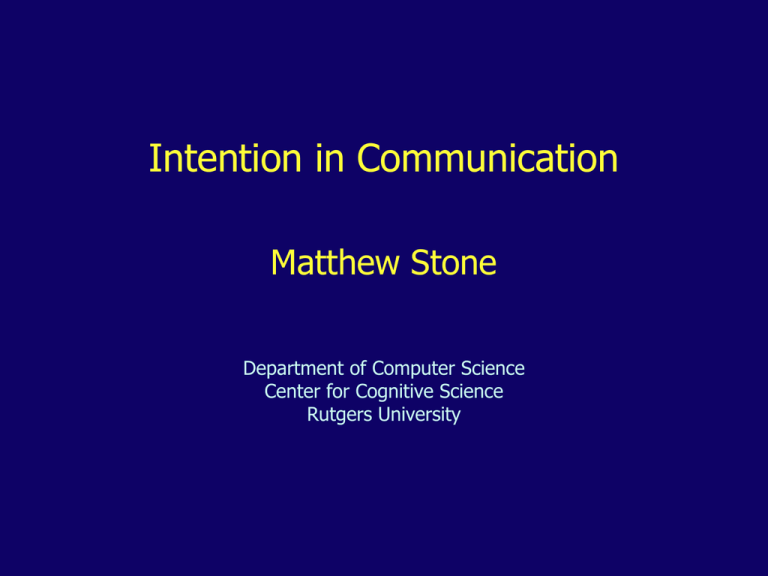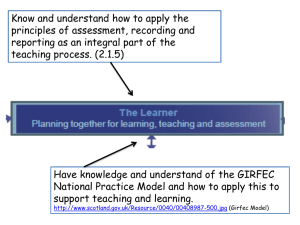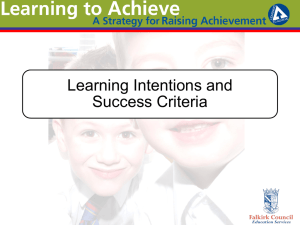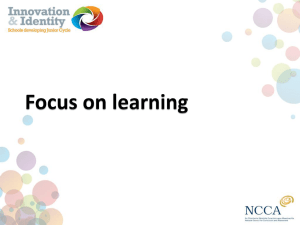Power Point - Princeton University
advertisement

Intention in Communication Matthew Stone Department of Computer Science Center for Cognitive Science Rutgers University Background Two ideas from Grice • Conversation is a case of collaboration • Meaning is a kind of intention Part of a common program (Neale 1992) • Ground language in a more general understanding of the social Goal for today Explain and motivate Grice’s views Get precise on what’s involved • What are intentions? • How are they used in collaboration? • What makes communication special? • How do we put these ideas together? Outline Introducing Intentions Approaches to Communicative Intentions The Appeal of the Gricean Picture Defending the Simple View Putting things together Introducing Intentions Background: RTM Key idea for deliberation (Newell & Simon) – Agent has symbols that designate its own processes – Agent “programs itself” – Church-Turing thesis Introducing Intentions RTM and action: Practical syllogism Infer Judgment: ‘A would be good’ Make Commitment: ‘I will do A’ Go: Agent therefore undertakes action A Represented judgments with particular content cause agent to take action Symbolic perspective Agent infers: ‘good(A)’ From there, agent makes commitment: ‘do(A)’ System exploits designation relation from symbol ‘A’ to action A: brings A about Special kind of intention Basic intentions Describe action as agent can actually run it – Causally grounded in system architecture and its relationship with environment – Indexicality, affordances, experience Two examples Hanging a picture • Basic intention: hit nail with hammer • Immediate effect: drive nail in Uttering a sentence • Basic intention: produce linguistic expression under specific grammatical analysis • Immediate effect: contribute conventional meaning Another kind of intention Future-oriented intentions – Abstract commitments – Constrain deliberation – Gradually refined – Issue in intentions-in-action Example Hanging a picture • Decide to get some art for a patch of wall • Constrains other decorating decisions • Leads to trip to gallery, hardware store • Eventually you find yourself with a picture hook, a hammer and a nail, ready to go Example Planning a date • Decide on dinner and a movie • Constrains time and place of dinner • Leads to choice of venue, call for reservations • Eventually, you find yourself asking maitre d’ for a table at a specific date and time Another kind of intention Intentions in action • Link basic intentions to future intentions • Complex, assumed network of cause-effect • Tracking broader commitments Example Hitting the nail with the hammer • To drive the nail in, • To mount the picture hook, • To hang the picture on, • To complete the decor Example Asking if there’s a table available • To make a reservation, • To arrange dinner, • To have a nice date Intention recognition Important social skill • Basic intentions • Future-oriented intentions • Intentions in action Intention recognition Evidence • Observed action • General human cognitive capabilities • Knowledge of cause and effect • Knowledge of others’ goals and beliefs • Observed deliberation Intentions in collaboration Two people hang a picture • One positions picture the other judges placement, marks hook • Hook goes up • One positions picture the other threads wire onto hook Intentions in collaboration Agreements in advance can make this work • Network of commitments for one’s own actions • Corresponding expectations for others’ actions • Appropriate shared status to coordinate and agree activity Intentions in collaboration Intention recognition can make this work • One commits to course of action • Embarks on the plan in a recognizable way • Others catch on and play their parts Outline Introducing Intentions Approaches to Communicative Intentions The Appeal of the Gricean Picture Defending the Simple View Putting things together Conversation as collaboration Interlocutors often have a joint interest in • Getting their ideas across • Reaching agreements with one another • Accomplishing shared projects These can ground out in joint intentions They may recognize—or signal—how utterances contribute to these intentions Case study A: I want to talk to Kathy. Can you give me the phone number to St. Eligius? S: St Eligius closed last month. Kathy was at Boston General. She’s already been discharged. You can call her at home at 5551238. Pollack 1990. Case Study Getting ideas across • Do you mean Kathy Smith or Kathy Jones? Reaching agreement • Kathy was at Boston General. Getting things done • You can call her at home at 555-1238. Conversation as collaboration Note: it’s an open question exactly when these kinds of collaboration are engaged. Unhelpful customer service—no uptake of practical goals Political debate—no real interest in agreement Monkey paw—deliberately construing ambiguous language in unintended ways Communicative Intentions Option 1: Dynamic Semantics • Basic intention: using an utterance, under a specific linguistic analysis, contributes conventional meaning to the conversation Requires separate understanding of meaning, conversation Communicative Intentions Simple application of RTM: – agent – agent – agent – agent wants to get idea across – “P” uses grammar to infer S means P concludes saying S would be good commits, says S Intention like any other – causal mechanism tracing action to complex antecedent mental state Communicative Intentions Option 2: Grice • Intention in action: using an utterance fits into a broader network of expectations • Speaker is ultimately committed to getting idea across in a special way • Audience recognizes whole package Speaker’s commitments anticipate audience’s reaction, in conventional or ad hoc ways. Getting clear on the difference Dynamic semantics • Basic intention determines utterance used • Settles ambiguity—attachment, coindexing, deixis, lexical senses, etc. • Interpretation thus involves recognizing what speaker had in mind But grounded in appropriate indexical mental representations of speaker’s Limits on intention in D.S. Deixis—refers to the entity causally involved in guiding gesture • Even if speaker is committed to talk about other entities, via false beliefs Words—retain meaning they have in the community, if speaker represents them in the usual way, via deference • Even if speaker is committed to use other meanings, via false beliefs Limits on intentions in D.S. Distinguishes conventional meaning from indirect effects No requirement of cooperation Creativity requires a special explanation • speaker extends language via coining • still work to be done to link new term to its meaning, perhaps as speaker intended Getting clear on the difference Grice’s approach • Contributions are fundamentally similar, whether conventional or indirect • Both have commitment to uptake, which is where the action is Getting clear on the difference Grice’s approach • Creative uses of language and conventional ones are fundamentally similar • Both involve similar commitment to uptake Getting clear on the difference Grice’s approach • No reason to privilege any description of communicative effects • For example in cases of false beliefs about meaning and reference • We look in an aggregate way at network of speaker’s commitments Getting clear on the difference Grice’s approach • Requires collaboration • Without collaboration, speaker not committed to uptake in right way and hence has no communicative intention Getting clear on the difference The difference is not • what intentions get recognized • how intention recognition smooths collaboration Dynamic semantics allows that interlocutors can and often do link basic intention to broader understanding of interlocutor’s present and future intentions Outline Introducing Intentions Approaches to Communicative Intentions The Appeal of the Gricean Picture Defending the Simple View Putting things together Creativity Improvised meaning and nonlinguistic action • Reaching to grab something in pretense (Sperber & Wilson) Coining new meanings of words Ambiguity Offers a very straightforward understanding of the idea that understanding recovers what the speaker had in mind Difficult to describe ambiguity without talking about intentions in some way Open-endedness Communication is arbitrary Intentions give an open-ended and inferential understanding of what utterances communicate Seems like a promising way to flesh out what’s up to us about communication Outline Introducing Intentions Approaches to Communicative Intentions The Appeal of the Gricean Picture Defending the Simple View Putting things together Malapropisms Inconceivable! You keep using that word. I do not think it means what you think it means. Seems like we sometimes hold people to interpretations that they didn’t intend. Inadvertent deixis That’s a great philosopher. [pointing at a picture of Spirow Agnew] Seems like we sometimes hold people to interpretations that they didn’t intend. Comparison with chess We have social rules • effect of moves is determined by the rules, not by our intentions or occurent mental states Outline Introducing Intentions Approaches to Communicative Intentions The Appeal of the Gricean Picture Defending the Simple View Putting things together Grice on Herod Herod presents Salome with John’s head. His act informs her John is dead but Herod act doesn’t mean that John is dead. He expects her to draw this conclusion from seeing John’s head, not from recognizing his intention. Herod’s act reveals but does not communicate, this info A “Gricean derivation” 1. Herod is cooperative, so he must be trying to get info across to me with his demonstration. 2. Not about the platter; that would be irrelevant & Herod is following Maxim of Relation. 3. So, must be about John. 4. But then it must be that he’s dead, by Maxim of Manner. Brandishing his head is a weird way to convey he has a beard or brown hair. 5. So, if Herod is being cooperative, I can infer he intends to show me that John is dead. Intention recognition is everywhere S says “bank.” A recognizes if S intends river or finances. Intention recognition in semantics. S says “Can you pass the salt?” A recognizes if S intends to request or to ask. Intention recognition in pragmatic rules. S says “There’s a bug!” A recognizes that S expects A to swat bug. Intention recognition in common-sense background. Intention recognition is everywhere So what? • claim that intentions disambiguate is boring Grice’s CIs, Relevance’s enrichment say more • claim is general inference delivers content Reasonable to challenge this claim






